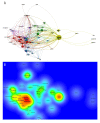Evolution of Inguinal Hernia Publications: A Bibliometric Analysis from 1980 to 2021
- PMID: 37095690
- PMCID: PMC10148596
- DOI: 10.12659/MSM.939613
Evolution of Inguinal Hernia Publications: A Bibliometric Analysis from 1980 to 2021
Abstract
BACKGROUND Despite the increasing number of studies published worldwide focusing on inguinal hernia, a major condition in the surgical field that affects the quality of life of many patients, a bibliometric study on inguinal hernia is yet to be conducted. The present study aimed to analyze the scientific articles published on inguinal hernia using statistical methods. MATERIAL AND METHODS Articles published between 1980 and 2021 on inguinal hernia were downloaded from the Web of Science database and analyzed using statistical methods. RESULTS A total of 11 761 publications were found. The top 5 contributors to the literature were the United States (n=2109, 27%), Germany (563, 6.7%), United Kingdom (595, 5.7%), Turkey (415, 5.3%), and Japan (388, 4.9%). The top 3 most influential journals by average number of citations per article were Annals of Surgery (citations: 67.4), British Journal of Surgery (citations: 49.9), and Surgical Clinics of North America (citations: 43.2). CONCLUSIONS In the current comprehensive bibliometric study on inguinal hernia, which has demonstrated an upward trend in the number of articles published recently, we present a summary of 7810 articles published from 1980 to 2021. According to the results of the analysis conducted to identify trending topics, the keywords studied in recent years are believed to include pediatric, outcomes, minimally invasive surgery, robotic, incisional hernia, umbilical hernia, chronic pain, obesity, bariatric surgery, NSQIP, seroma, surgical site infection, abdominal wall reconstruction, ventral hernia repair, and hiatal hernia repair.
Conflict of interest statement
Figures







Similar articles
-
Bibliometric analysis of the scientific production on inguinal hernia surgery in the web of science.Front Surg. 2023 Mar 22;10:1138805. doi: 10.3389/fsurg.2023.1138805. eCollection 2023. Front Surg. 2023. PMID: 37035575 Free PMC article.
-
Minimally-invasive cardiac surgery: a bibliometric analysis of impact and force to identify key and facilitating advanced training.J Cardiothorac Surg. 2022 Sep 16;17(1):236. doi: 10.1186/s13019-022-01988-3. J Cardiothorac Surg. 2022. PMID: 36114506 Free PMC article.
-
A Bibliometric Study of the Pediatric Inguinal Hernia Publication Landscape from the Web of Science Database.J Indian Assoc Pediatr Surg. 2022 Nov-Dec;27(6):689-698. doi: 10.4103/jiaps.jiaps_27_22. Epub 2022 Nov 14. J Indian Assoc Pediatr Surg. 2022. PMID: 36714482 Free PMC article.
-
The 100 most influential publications in asthma from 1960 to 2017: A bibliometric analysis.Respir Med. 2018 Apr;137:206-212. doi: 10.1016/j.rmed.2018.03.014. Epub 2018 Mar 13. Respir Med. 2018. PMID: 29605206 Review.
-
The top 100 most-cited papers in incisional hernia: a bibliometric analysis from 2003 to 2023.Hernia. 2024 Apr;28(2):333-342. doi: 10.1007/s10029-023-02909-6. Epub 2023 Oct 28. Hernia. 2024. PMID: 37897504 Review.
Cited by
-
Impact of the ventral hernia working group's publication: a bibliometric analysis.Hernia. 2024 Oct;28(5):1843-1848. doi: 10.1007/s10029-024-03093-x. Epub 2024 Jun 18. Hernia. 2024. PMID: 38888837 Free PMC article.
-
Comprehensive bibliometric and visualized analysis of research on incisional hernia and component separation from 1996 to 2023.JPRAS Open. 2025 Apr 25;45:76-88. doi: 10.1016/j.jpra.2025.04.012. eCollection 2025 Sep. JPRAS Open. 2025. PMID: 40519812 Free PMC article. Review.
References
-
- Kraft BM, Kolb H, Kuckuk B, et al. Diagnosis and classification of inguinal hernias. Surg Endosc. 2003;17(12):2021–24. - PubMed
-
- Gallegos NC, Dawson J, Jarvis M, Hobsley M. Risk of strangulation in groin hernias. Br J Surg. 1991;78(10):1171–73. - PubMed
-
- Lichtenstein IL, Shulman AG, Amid PK, Montllor MM. The tension-free hernioplasty. Am J Surg. 1989;157(2):188–93. - PubMed
MeSH terms
LinkOut - more resources
Full Text Sources

